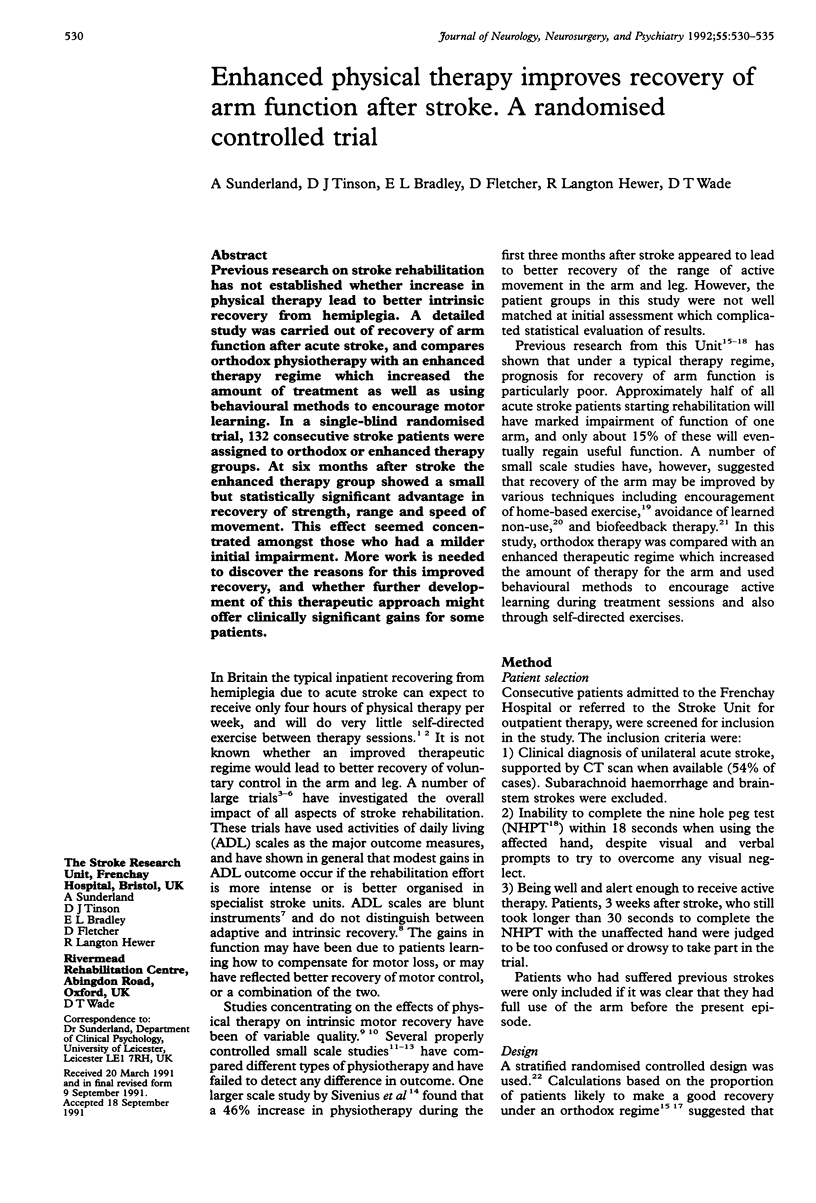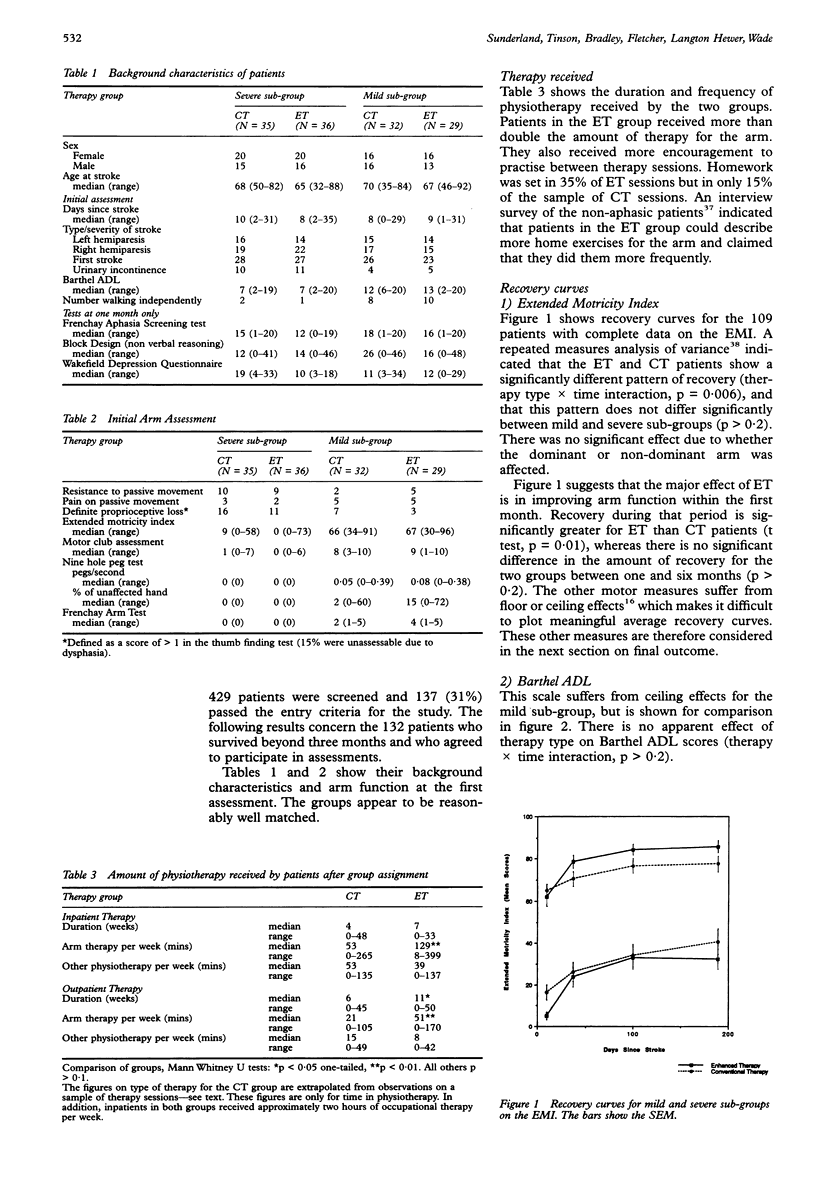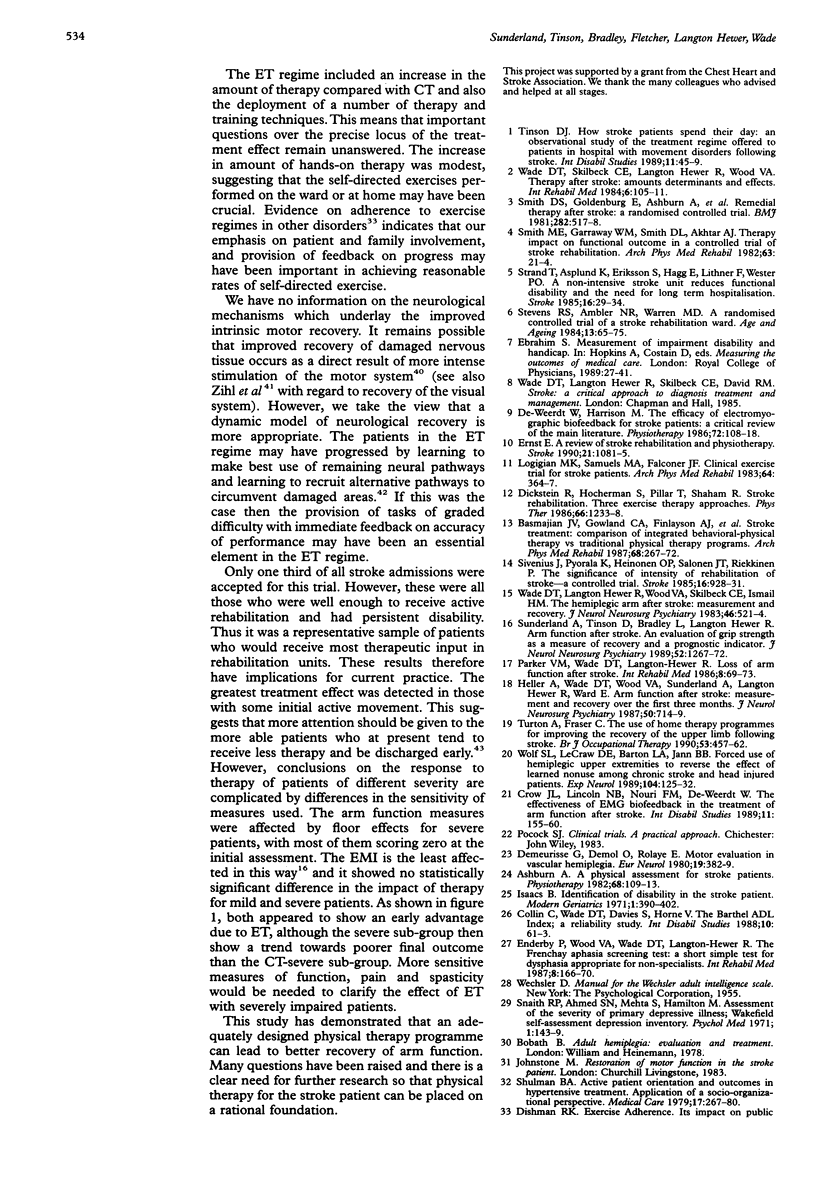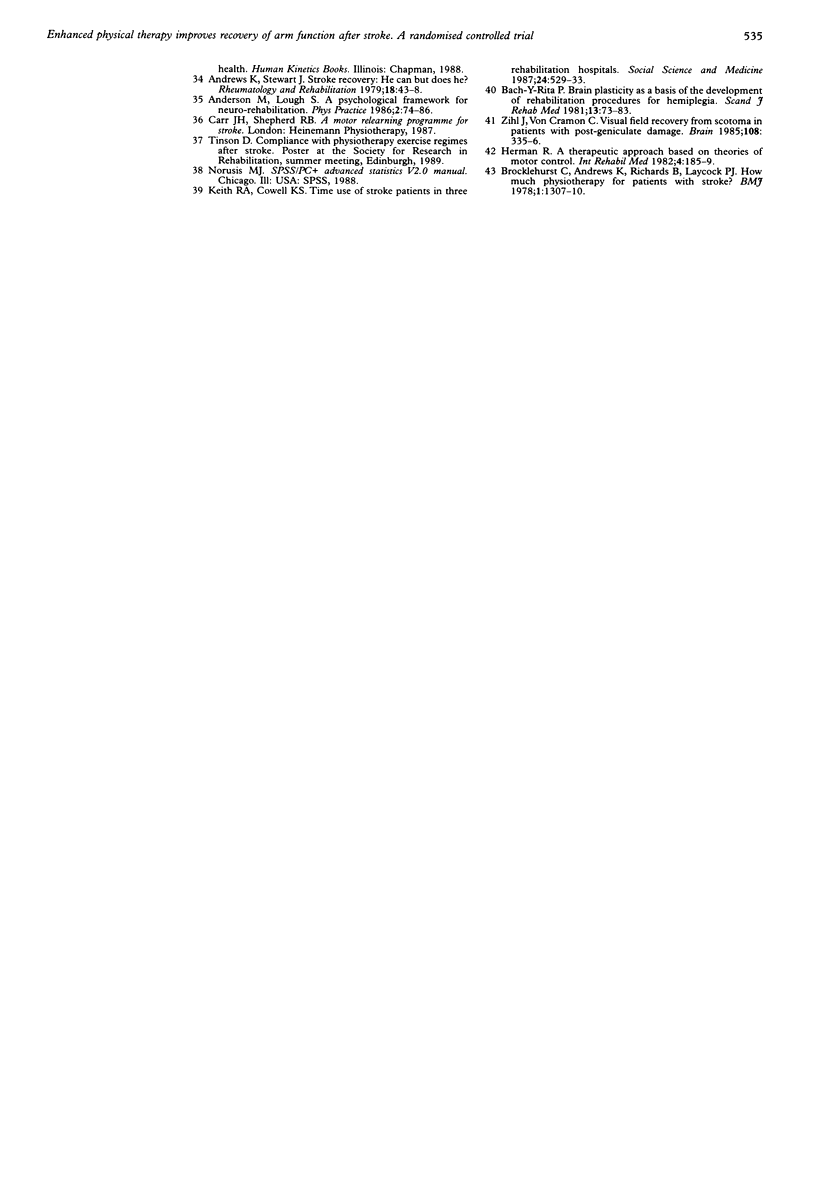Abstract
Previous research on stroke rehabilitation has not established whether increase in physical therapy lead to better intrinsic recovery from hemiplegia. A detailed study was carried out of recovery of arm function after acute stroke, and compares orthodox physiotherapy with an enhanced therapy regime which increased the amount of treatment as well as using behavioural methods to encourage motor learning. In a single-blind randomised trial, 132 consecutive stroke patients were assigned to orthodox or enhanced therapy groups. At six months after stroke the enhanced therapy group showed a small but statistically significant advantage in recovery of strength, range and speed of movement. This effect seemed concentrated amongst those who had a milder initial impairment. More work is needed to discover the reasons for this improved recovery, and whether further development of this therapeutic approach might offer clinically significant gains for some patients.
Full text
PDF





Selected References
These references are in PubMed. This may not be the complete list of references from this article.
- Andrews K., Stewart J. Stroke recovery: he can but does he? Rheumatol Rehabil. 1979 Feb;18(1):43–48. doi: 10.1093/rheumatology/18.1.43. [DOI] [PubMed] [Google Scholar]
- Ashburn A. A physical assessment for stroke patients. Physiotherapy. 1982 Apr;68(4):109–113. [PubMed] [Google Scholar]
- Bach-y-Rita P. Brain plasticity as a basis of the development of rehabilitation procedures for hemiplegia. Scand J Rehabil Med. 1981;13(2-3):73–83. [PubMed] [Google Scholar]
- Basmajian J. V., Gowland C. A., Finlayson M. A., Hall A. L., Swanson L. R., Stratford P. W., Trotter J. E., Brandstater M. E. Stroke treatment: comparison of integrated behavioral-physical therapy vs traditional physical therapy programs. Arch Phys Med Rehabil. 1987 May;68(5 Pt 1):267–272. [PubMed] [Google Scholar]
- Brocklehurst J. C., Andrews K., Richards B., Laycock P. J. How much physical therapy for patients with stroke? Br Med J. 1978 May 20;1(6123):1307–1310. doi: 10.1136/bmj.1.6123.1307. [DOI] [PMC free article] [PubMed] [Google Scholar]
- Collin C., Wade D. T., Davies S., Horne V. The Barthel ADL Index: a reliability study. Int Disabil Stud. 1988;10(2):61–63. doi: 10.3109/09638288809164103. [DOI] [PubMed] [Google Scholar]
- Crow J. L., Lincoln N. B., Nouri F. M., De Weerdt W. The effectiveness of EMG biofeedback in the treatment of arm function after stroke. Int Disabil Stud. 1989 Oct-Dec;11(4):155–160. doi: 10.3109/03790798909166667. [DOI] [PubMed] [Google Scholar]
- Demeurisse G., Demol O., Robaye E. Motor evaluation in vascular hemiplegia. Eur Neurol. 1980;19(6):382–389. doi: 10.1159/000115178. [DOI] [PubMed] [Google Scholar]
- Dickstein R., Hocherman S., Pillar T., Shaham R. Stroke rehabilitation. Three exercise therapy approaches. Phys Ther. 1986 Aug;66(8):1233–1238. doi: 10.1093/ptj/66.8.1233. [DOI] [PubMed] [Google Scholar]
- Enderby P. M., Wood V. A., Wade D. T., Hewer R. L. The Frenchay Aphasia Screening Test: a short, simple test for aphasia appropriate for non-specialists. Int Rehabil Med. 1987;8(4):166–170. doi: 10.3109/03790798709166209. [DOI] [PubMed] [Google Scholar]
- Ernst E. A review of stroke rehabilitation and physiotherapy. Stroke. 1990 Jul;21(7):1081–1085. doi: 10.1161/01.str.21.7.1081. [DOI] [PubMed] [Google Scholar]
- Heller A., Wade D. T., Wood V. A., Sunderland A., Hewer R. L., Ward E. Arm function after stroke: measurement and recovery over the first three months. J Neurol Neurosurg Psychiatry. 1987 Jun;50(6):714–719. doi: 10.1136/jnnp.50.6.714. [DOI] [PMC free article] [PubMed] [Google Scholar]
- Herman R. Rehabilitation following brain damage: some neurophysiological mechanisms. A therapeutic approach based on theories of motor control. Int Rehabil Med. 1982;4(4):185–189. doi: 10.3109/09638288209166915. [DOI] [PubMed] [Google Scholar]
- Keith R. A., Cowell K. S. Time use of stroke patients in three rehabilitation hospitals. Soc Sci Med. 1987;24(6):529–533. doi: 10.1016/0277-9536(87)90342-x. [DOI] [PubMed] [Google Scholar]
- Logigian M. K., Samuels M. A., Falconer J., Zagar R. Clinical exercise trial for stroke patients. Arch Phys Med Rehabil. 1983 Aug;64(8):364–367. [PubMed] [Google Scholar]
- Parker V. M., Wade D. T., Langton Hewer R. Loss of arm function after stroke: measurement, frequency, and recovery. Int Rehabil Med. 1986;8(2):69–73. doi: 10.3109/03790798609166178. [DOI] [PubMed] [Google Scholar]
- Schulman B. A. Active patient orientation and outcomes in hypertensive treatment: application of a socio-organizational perspective. Med Care. 1979 Mar;17(3):267–280. doi: 10.1097/00005650-197903000-00004. [DOI] [PubMed] [Google Scholar]
- Sivenius J., Pyörälä K., Heinonen O. P., Salonen J. T., Riekkinen P. The significance of intensity of rehabilitation of stroke--a controlled trial. Stroke. 1985 Nov-Dec;16(6):928–931. doi: 10.1161/01.str.16.6.928. [DOI] [PubMed] [Google Scholar]
- Smith D. S., Goldenberg E., Ashburn A., Kinsella G., Sheikh K., Brennan P. J., Meade T. W., Zutshi D. W., Perry J. D., Reeback J. S. Remedial therapy after stroke: a randomised controlled trial. Br Med J (Clin Res Ed) 1981 Feb 14;282(6263):517–520. doi: 10.1136/bmj.282.6263.517. [DOI] [PMC free article] [PubMed] [Google Scholar]
- Smith M. E., Garraway W. M., Smith D. L., Akhtar A. J. Therapy impact on functional outcome in a controlled trial of stroke rehabilitation. Arch Phys Med Rehabil. 1982 Jan;63(1):21–24. [PubMed] [Google Scholar]
- Snaith R. P., Ahmed S. N., Mehta S., Hamilton M. Assessment of the severity of primary depressive illness. Wakefield self-assessment depression inventory. Psychol Med. 1971 Feb;1(2):143–149. doi: 10.1017/s0033291700000064. [DOI] [PubMed] [Google Scholar]
- Stevens R. S., Ambler N. R., Warren M. D. A randomized controlled trial of a stroke rehabilitation ward. Age Ageing. 1984 Mar;13(2):65–75. doi: 10.1093/ageing/13.2.65. [DOI] [PubMed] [Google Scholar]
- Strand T., Asplund K., Eriksson S., Hägg E., Lithner F., Wester P. O. A non-intensive stroke unit reduces functional disability and the need for long-term hospitalization. Stroke. 1985 Jan-Feb;16(1):29–34. doi: 10.1161/01.str.16.1.29. [DOI] [PubMed] [Google Scholar]
- Sunderland A., Tinson D., Bradley L., Hewer R. L. Arm function after stroke. An evaluation of grip strength as a measure of recovery and a prognostic indicator. J Neurol Neurosurg Psychiatry. 1989 Nov;52(11):1267–1272. doi: 10.1136/jnnp.52.11.1267. [DOI] [PMC free article] [PubMed] [Google Scholar]
- Tinson D. J. How stroke patients spend their days. An observational study of the treatment regime offered to patients in hospital with movement disorders following stroke. Int Disabil Stud. 1989 Jan-Mar;11(1):45–49. doi: 10.3109/02599148909166380. [DOI] [PubMed] [Google Scholar]
- Wade D. T., Langton-Hewer R., Wood V. A., Skilbeck C. E., Ismail H. M. The hemiplegic arm after stroke: measurement and recovery. J Neurol Neurosurg Psychiatry. 1983 Jun;46(6):521–524. doi: 10.1136/jnnp.46.6.521. [DOI] [PMC free article] [PubMed] [Google Scholar]
- Wade D. T., Skilbeck C. E., Hewer R. L., Wood V. A. Therapy after stroke: amounts, determinants and effects. Int Rehabil Med. 1984;6(3):105–110. doi: 10.3109/03790798409165926. [DOI] [PubMed] [Google Scholar]
- Wolf S. L., Lecraw D. E., Barton L. A., Jann B. B. Forced use of hemiplegic upper extremities to reverse the effect of learned nonuse among chronic stroke and head-injured patients. Exp Neurol. 1989 May;104(2):125–132. doi: 10.1016/s0014-4886(89)80005-6. [DOI] [PubMed] [Google Scholar]
- Zihl J., von Cramon D. Visual field recovery from scotoma in patients with postgeniculate damage. A review of 55 cases. Brain. 1985 Jun;108(Pt 2):335–365. doi: 10.1093/brain/108.2.335. [DOI] [PubMed] [Google Scholar]


